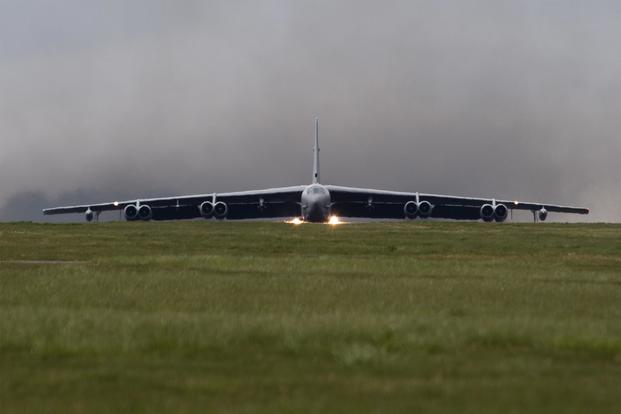The U.S. Air Force is planning more shorter strategic bomber rotations in order to test its agility when deploying its heavy aircraft forces around the world, the head of Air Force Global Strike Command said Wednesday.
"I am focused a lot on a different operational mentality in the command, to think about great power competition," Gen Timothy Ray told reporters during a Defense Writers Group breakfast in Washington, D.C.
Ray, who previously served as deputy commander of U.S. European Command, said he was against a "steady bomber force" in Europe, or anywhere in the world for that matter.
"Why would I do that?" Ray said. "Why wouldn't I [instead] bring significant combat capability to the theater in a time and place of our choosing and...bring regional stability [to allies and partners?]"
Last month, the command deployed six B-52 Stratofortresses and more than 400 personnel from the 2nd Bomb Wing at Barksdale Air Force Base, Louisiana, to RAF Fairford, England for a month-long rotation.
Related content:
- The Next B-52 Bomb Upgrade May Be a Tough Message for China
- B-52 Bombers Arrive in Europe for Integration Exercises and Training
- Overtasking of B-1 Lancer Fleet Led to Faster Deterioration, General Says
The deployment, in support of U.S. Strategic Command's "Bomber Task Force" exercise, marked the largest deployment of one bomber platform to Europe since 2003, when the command had nearly 20 bombers at Fairford in support of Operation Iraqi Freedom.
In the most recent deployment, the last of the bombers and airmen and four C-17 Globemaster III's worth of support equipment departed April 11, Air Force Times reported.
The European theater has had a bomber rotation at least once a year as part of Operation Atlantic Resolve since Russia's annexation of Crimea in 2014.
The Pentagon sent two B-2 Spirit bombers and three B-52s to Europe that year for training events days after then-President Barack Obama announced he would increase U.S. military presence in the region -- an apparent response to Russia's actions. Since then, the bomber variants -- including the B-1B Lancer -- have operated in European airspace alongside NATO allies.
"I think that signals a little bit more of the dynamic approach that we're going to take," Ray said.
In the latest rotation, B-52s were spotted flying throughout the continent and over the Baltic, Norwegian and Mediterranean Seas. They had conducted simulations with Joint Terminal Attack controllers on the ground in Estonia and Romania, and flew with Italian air force Typhoon fighter jets to support the NATO Icelandic Air Surveillance mission, according to multiple releases and media reports.
When asked if the Russians should take into account that additional U.S. bomber deployments are expected, Ray said, "The world should take [that] into account."
"We're going to go to Central Command, we're going to go to the Pacific. We're going to go to lots of places," he added.
The reasoning behind the strategic shift is to exercise a "dynamic force employment," Ray said. "To bring long range precision strike into any theater ... along with our allies," he said.
Meanwhile, nuclear-capable B-52s from the 5th Bomb Wing, Minot Air Force Base, North Dakota, have been training in the Pacific as part of the continuous bomber mission there, and have been spotted a few times near the East and South China Seas alongside regional allies.
With an uptick in global competition from Russia in Europe and China in the Pacific, agility "is something we need to be very good at," Ray said.
The general did not say which bomber variant would deploy next as part of the new strategy, or when the deployment would take place.
-- Oriana Pawlyk can be reached at oriana.pawlyk@military.com. Follow her on Twitter at @oriana0214.












